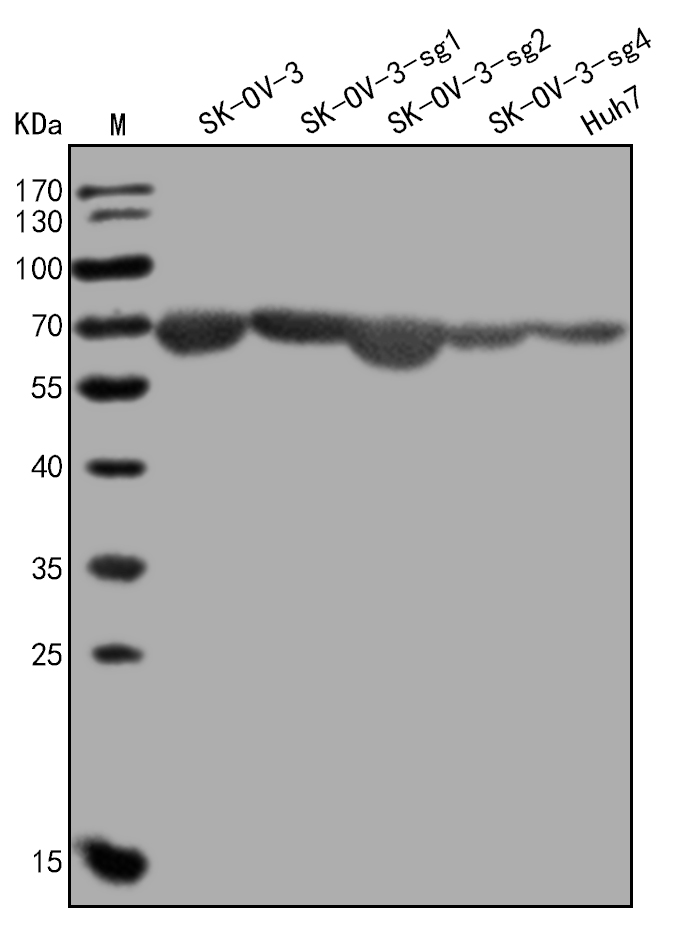
Anti-PPARG Antibody, Rabbit Polyclonal
產(chǎn)品編號(hào):PA00109HuA10
$ 詢(xún)價(jià)
規(guī)格 50uL 100uL 200uL
 |
說(shuō)明書(shū) |
產(chǎn)品名稱(chēng):Anti-PPARG Antibody, Rabbit Polyclonal
經(jīng)驗(yàn)證的應(yīng)用:WB/IHC/IF/ICC
交叉反應(yīng):Hu
特異性:human PPARG
免疫原:Recombinant human PPARG protein, fragment Asp238~Asp503; UniprotKB: P37231
制備方法:Produced in rabbits immunized with human PPARG, and purified by antigen affinity chromatography.
來(lái)源:Polyclonal Rabbit IgG
純化:Immunogen affinity purified
緩沖液:Supplied in PBS, 50% glycerol and less than 0.02% sodium azide, PH7.4
偶聯(lián)物:Unconjugated
狀態(tài):Liquid
運(yùn)輸方式:This antibody is shipped as liquid solution at ambient temperature. Upon receipt, store it immediately at the temperature recommended.
儲(chǔ)存條件:This antibody can be stored at 2℃-8℃ for one month without detectable loss of activity. Antibody products are stable for twelve months from date of receipt when stored at -20℃ to -80℃. Preservative-Free. Avoid repeated freeze-thaw cycles.
圖片:
Figure1.Western blot analysis of extracts of various tissues , using PPARG antibody (PA00109HuA10) at 2ug/ml dilution.Secondary antibody: HRP Goat Anti-Rabbit IgG (H+L) at 1:10000 dilution.Blocking buffer: 5% nonfat dry milk in TBST.
別稱(chēng):PPAR-G, PPARG1, PPARG2, NR1C3, Glitazone Receptor, Nuclear Receptor Subfamily 1 Group C Member 3
背景信息:Peroxisome Proliferator-Activated Receptors (PPARs) are ligand-activated intracellular transcription factors, members of the nuclear hormone receptor superfamily (NR), that includes estrogen, thyroid hormone receptors, retinoic acid, Vitamin D3 as well as retinoid X receptors (RXRs). The PPAR subfamily consists of three subtypes encoded by distinct genes denoted PPARα (NR1C1), PPARβ/δ (NR1C2) and PPARγ (NR1C3), which are activated by selective ligands. PPARγ, also named as PPARG, contains one nuclear receptor DNA-binding domain and is a receptor that binds peroxisome proliferators such as hypolipidemic drugs and fatty acids. It plays an important role in the regulation of lipid homeostasis, adipogenesis, ins resistance, and development of various organs. Defects in PPARG are the cause of familial partial lipodystrophy type 3 (FPLD3) and may be associated with susceptibility to obesity. Defects in PPARG can lead to type 2 ins-resistant diabetes and hypertension. PPARG mutations may be associated with colon cancer. Genetic variations in PPARG are associated with susceptibility to glioma type 1 (GLM1). PPARG has two isoforms with molecular weight 57 kDa and 54 kDa (PMID: 9831621), but modified PPARG is about 67 KDa (PMID: 16809887). PPARG2 is a splice variant and has an additional 30 amino acids at the N-terminus (PMID: 15689403). Experimental data indicate that a 45 kDa protein displaying three different sequences immunologically related to the nuclear receptor PPARG2 is located in mitochondria (mt-PPAR). However, the molecular weight of this protein is clearly less when compared to that of PPARG2 (57 kDa) (PMID: 10922459). PPARG has been reported to be localized mainly (but not always) in the nucleus. PPARG can also be detected in the cytoplasm and was reported to possess extra-nuclear/non-genomic actions (PMID: 17611413; 19432669; 14681322).
全稱(chēng):Peroxisome proliferator-activated receptor gamma (PPARG)
經(jīng)驗(yàn)證的應(yīng)用:WB/IHC/IF/ICC
交叉反應(yīng):Hu
特異性:human PPARG
免疫原:Recombinant human PPARG protein, fragment Asp238~Asp503; UniprotKB: P37231
制備方法:Produced in rabbits immunized with human PPARG, and purified by antigen affinity chromatography.
來(lái)源:Polyclonal Rabbit IgG
純化:Immunogen affinity purified
緩沖液:Supplied in PBS, 50% glycerol and less than 0.02% sodium azide, PH7.4
偶聯(lián)物:Unconjugated
狀態(tài):Liquid
運(yùn)輸方式:This antibody is shipped as liquid solution at ambient temperature. Upon receipt, store it immediately at the temperature recommended.
儲(chǔ)存條件:This antibody can be stored at 2℃-8℃ for one month without detectable loss of activity. Antibody products are stable for twelve months from date of receipt when stored at -20℃ to -80℃. Preservative-Free. Avoid repeated freeze-thaw cycles.
圖片:
Figure1.Western blot analysis of extracts of various tissues , using PPARG antibody (PA00109HuA10) at 2ug/ml dilution.Secondary antibody: HRP Goat Anti-Rabbit IgG (H+L) at 1:10000 dilution.Blocking buffer: 5% nonfat dry milk in TBST.
別稱(chēng):PPAR-G, PPARG1, PPARG2, NR1C3, Glitazone Receptor, Nuclear Receptor Subfamily 1 Group C Member 3
背景信息:Peroxisome Proliferator-Activated Receptors (PPARs) are ligand-activated intracellular transcription factors, members of the nuclear hormone receptor superfamily (NR), that includes estrogen, thyroid hormone receptors, retinoic acid, Vitamin D3 as well as retinoid X receptors (RXRs). The PPAR subfamily consists of three subtypes encoded by distinct genes denoted PPARα (NR1C1), PPARβ/δ (NR1C2) and PPARγ (NR1C3), which are activated by selective ligands. PPARγ, also named as PPARG, contains one nuclear receptor DNA-binding domain and is a receptor that binds peroxisome proliferators such as hypolipidemic drugs and fatty acids. It plays an important role in the regulation of lipid homeostasis, adipogenesis, ins resistance, and development of various organs. Defects in PPARG are the cause of familial partial lipodystrophy type 3 (FPLD3) and may be associated with susceptibility to obesity. Defects in PPARG can lead to type 2 ins-resistant diabetes and hypertension. PPARG mutations may be associated with colon cancer. Genetic variations in PPARG are associated with susceptibility to glioma type 1 (GLM1). PPARG has two isoforms with molecular weight 57 kDa and 54 kDa (PMID: 9831621), but modified PPARG is about 67 KDa (PMID: 16809887). PPARG2 is a splice variant and has an additional 30 amino acids at the N-terminus (PMID: 15689403). Experimental data indicate that a 45 kDa protein displaying three different sequences immunologically related to the nuclear receptor PPARG2 is located in mitochondria (mt-PPAR). However, the molecular weight of this protein is clearly less when compared to that of PPARG2 (57 kDa) (PMID: 10922459). PPARG has been reported to be localized mainly (but not always) in the nucleus. PPARG can also be detected in the cytoplasm and was reported to possess extra-nuclear/non-genomic actions (PMID: 17611413; 19432669; 14681322).
全稱(chēng):Peroxisome proliferator-activated receptor gamma (PPARG)

